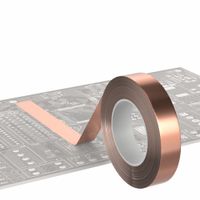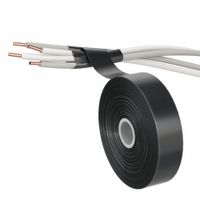Call +(254) 703 030 000 / 751 483 999 / 721 704 777
- Home
- Adhesives Sealants And Tape
- Tape
- Electrical Tape
.....Read More
Frequently Asked Questions
What is the difference between insulating and conductive electrical tape?
Insulating electrical tape and conductive electrical tape serve different purposes in electrical applications.
Insulating electrical tape is designed to prevent the flow of electricity. It is typically made from materials like vinyl or rubber, which are excellent insulators. This type of tape is used to wrap and insulate electrical wires and other components to prevent electrical leakage, short circuits, and to protect against moisture and corrosion. It is commonly used in household wiring, automotive applications, and any situation where electrical insulation is required. Insulating tape is available in various colors, often used for color-coding wires.
Conductive electrical tape, on the other hand, is designed to allow the flow of electricity. It is made from materials that conduct electricity, such as copper or aluminum, often with an adhesive backing that also conducts electricity. This type of tape is used in applications where electrical connections need to be made or maintained, such as in grounding, EMI/RFI shielding, and in the repair of circuit boards. Conductive tape is often used in electronics, telecommunications, and aerospace industries.
In summary, the primary difference lies in their function: insulating tape prevents electrical flow, while conductive tape facilitates it.
How do you use conductive electrical tape for grounding?
To use conductive electrical tape for grounding, follow these steps:
1. **Select the Right Tape**: Choose a conductive tape made of materials like copper or aluminum, which have adhesive backing with conductive properties.
2. **Prepare the Surface**: Clean the surfaces where the tape will be applied to ensure good adhesion and conductivity. Remove any dust, grease, or debris.
3. **Cut the Tape**: Measure and cut the tape to the required length, ensuring it covers the necessary area to establish a good electrical connection.
4. **Apply the Tape**: Peel off the backing and carefully apply the tape to the surface, ensuring it is smooth and free of wrinkles or air bubbles. Press firmly to ensure good adhesion.
5. **Connect to Ground**: Extend the tape to a grounding point, such as a metal chassis or a grounding bus bar. Ensure the tape makes direct contact with the grounding point for effective grounding.
6. **Overlap for Continuity**: If multiple strips of tape are needed, overlap them slightly to maintain electrical continuity. Ensure the adhesive sides are in contact to allow current flow.
7. **Secure Connections**: Use additional fasteners or clips if necessary to secure the tape, especially in areas subject to movement or vibration.
8. **Test the Grounding**: Use a multimeter to check the continuity and resistance of the grounding path. Ensure the resistance is low enough to provide effective grounding.
9. **Inspect Regularly**: Periodically inspect the tape for wear, damage, or loss of adhesion, and replace it if necessary to maintain effective grounding.
By following these steps, conductive electrical tape can be effectively used for grounding applications, providing a reliable path for electrical discharge.
Can insulating electrical tape be used for shielding against EMI and RFI?
No, insulating electrical tape cannot be used for shielding against EMI (Electromagnetic Interference) and RFI (Radio Frequency Interference). Insulating electrical tape is primarily designed to provide electrical insulation and mechanical protection for wires and cables. It is typically made from materials like PVC or vinyl, which do not have the conductive properties necessary to block or reflect electromagnetic or radio frequency waves.
For effective EMI and RFI shielding, materials with conductive properties are required. These materials can absorb or reflect electromagnetic waves, thereby reducing interference. Common materials used for shielding include metal foils (such as copper or aluminum), conductive fabrics, and specialized shielding tapes that incorporate conductive layers.
Shielding effectiveness depends on several factors, including the material's conductivity, thickness, and the frequency of the interference. Conductive tapes or foils are often used in applications where flexible or easily applied shielding is needed. These materials can be wrapped around cables, placed inside enclosures, or used to cover seams and gaps in electronic devices to prevent interference.
In summary, while insulating electrical tape is useful for its intended purpose of insulation, it lacks the necessary properties to serve as an effective shield against EMI and RFI. For such applications, specialized conductive materials are required to ensure adequate protection against interference.
What are the applications of conductive electrical tape in electronics?
Conductive electrical tape is widely used in electronics for its ability to conduct electricity while providing insulation and mechanical support. Here are some key applications:
1. **EMI/RFI Shielding**: Conductive tape is used to shield electronic devices from electromagnetic interference (EMI) and radio frequency interference (RFI). It is applied to enclosures, cables, and connectors to prevent interference that can affect device performance.
2. **Grounding**: It provides a reliable grounding path in electronic assemblies. Conductive tape can be used to connect different parts of a circuit to a common ground, ensuring safety and functionality.
3. **Static Charge Dissipation**: In environments sensitive to static electricity, conductive tape helps dissipate static charges, protecting sensitive electronic components from electrostatic discharge (ESD) damage.
4. **Flexible Circuitry**: Conductive tape is used in flexible circuits where traditional wiring is impractical. It allows for the creation of flexible connections in wearable electronics, foldable devices, and other applications requiring flexibility.
5. **Repair and Prototyping**: It is used for quick repairs and modifications in circuit boards and electronic devices. Conductive tape can bridge broken traces or create temporary connections during prototyping.
6. **Antenna Design**: In RF applications, conductive tape is used to create or modify antennas. It allows for easy adjustments and fine-tuning of antenna designs.
7. **Battery Connections**: Conductive tape is used to connect batteries to circuits, especially in compact or portable devices where space is limited.
8. **Touch Screens and Sensors**: It is used in the construction of touch screens and sensors, providing conductive pathways that are essential for their operation.
9. **LED Strip Lighting**: Conductive tape is used to connect LED strips, providing both electrical connectivity and mechanical support.
These applications highlight the versatility and importance of conductive electrical tape in modern electronics.
Is electrical tape safe for high voltage applications?
Electrical tape is generally not recommended for high voltage applications. While it is designed to insulate electrical wires and other materials that conduct electricity, its effectiveness is limited to low to moderate voltage levels. Most standard electrical tapes are rated for up to 600 volts, which is suitable for household and light commercial applications. However, high voltage applications, typically defined as those exceeding 1,000 volts, require specialized insulation materials.
The primary concerns with using standard electrical tape in high voltage scenarios include its dielectric strength, thermal resistance, and adhesive properties. High voltage can cause electrical tape to degrade, lose its adhesive properties, or even melt, leading to potential safety hazards such as short circuits, electrical fires, or electric shock.
For high voltage applications, it is crucial to use materials specifically designed to handle such conditions. High voltage insulating tapes, often made from materials like silicone, rubber, or specialized polymers, are engineered to withstand higher voltages, extreme temperatures, and environmental factors. These tapes have higher dielectric strength, better thermal resistance, and more robust adhesive properties, ensuring reliable insulation and safety.
In summary, while electrical tape is useful for many electrical insulation tasks, it is not suitable for high voltage applications. For such scenarios, it is essential to use high voltage insulating tapes or other appropriate materials to ensure safety and compliance with electrical standards.
How do you properly apply insulating electrical tape to wires?
To properly apply insulating electrical tape to wires, follow these steps:
1. **Preparation**: Ensure the wires are clean and dry. Remove any old tape or insulation remnants. If the wire is frayed or damaged, trim it to expose fresh wire.
2. **Choose the Right Tape**: Use high-quality electrical tape designed for insulation. It should be flexible, durable, and have good adhesive properties.
3. **Start Wrapping**: Begin wrapping the tape around the wire at least an inch before the exposed section. This ensures a secure hold and prevents slippage.
4. **Overlap the Tape**: As you wrap, overlap each layer of tape by about half its width. This creates a double layer of insulation and enhances durability.
5. **Maintain Tension**: Keep the tape under slight tension as you wrap. This ensures a snug fit and helps the tape adhere better to the wire.
6. **Cover the Exposed Wire**: Continue wrapping until you have completely covered the exposed section of the wire. Extend the tape at least an inch beyond the exposed area to ensure full coverage.
7. **Secure the End**: Once the wire is fully covered, cut the tape and press the end firmly against the wrapped section. This prevents the tape from unraveling.
8. **Check for Gaps**: Inspect the wrapped wire for any gaps or loose sections. Re-wrap if necessary to ensure complete insulation.
9. **Test the Connection**: After wrapping, test the wire connection to ensure it is secure and functioning properly.
10. **Safety Precautions**: Always ensure the power is off before working with electrical wires. Use appropriate personal protective equipment.
By following these steps, you ensure a safe and effective insulation of electrical wires, reducing the risk of electrical hazards.
What materials are used in conductive electrical tape for effective bonding?
Conductive electrical tape is designed to provide electrical conductivity and effective bonding in various applications. The primary materials used in conductive electrical tape include:
1. **Conductive Metal Foils**: The most common conductive materials are metal foils such as copper, aluminum, or nickel. Copper is widely used due to its excellent electrical conductivity and flexibility. Aluminum is also popular for its lightweight and cost-effectiveness, while nickel offers good corrosion resistance.
2. **Conductive Adhesives**: The adhesive layer is crucial for bonding and maintaining conductivity. Conductive adhesives are typically made from acrylic, silicone, or rubber-based compounds infused with conductive fillers like silver, nickel, or carbon particles. Silver is preferred for its superior conductivity, though it is more expensive.
3. **Backing Material**: The backing provides structural support and can be made from materials like polyester, polyimide, or other flexible polymers. These materials offer durability, flexibility, and resistance to environmental factors.
4. **Conductive Fabrics**: In some tapes, conductive fabrics made from woven or non-woven fibers coated with conductive metals are used. These fabrics provide flexibility and are often used in applications requiring conformability.
5. **Carbon-Based Materials**: Carbon nanotubes or graphene may be incorporated for enhanced conductivity and flexibility, especially in advanced applications.
6. **Protective Coatings**: Some tapes include protective coatings to enhance durability, resist oxidation, and improve environmental resistance.
These materials are combined to create a tape that not only conducts electricity but also adheres well to various surfaces, providing reliable electrical connections in applications such as EMI/RFI shielding, grounding, and static charge dissipation.

